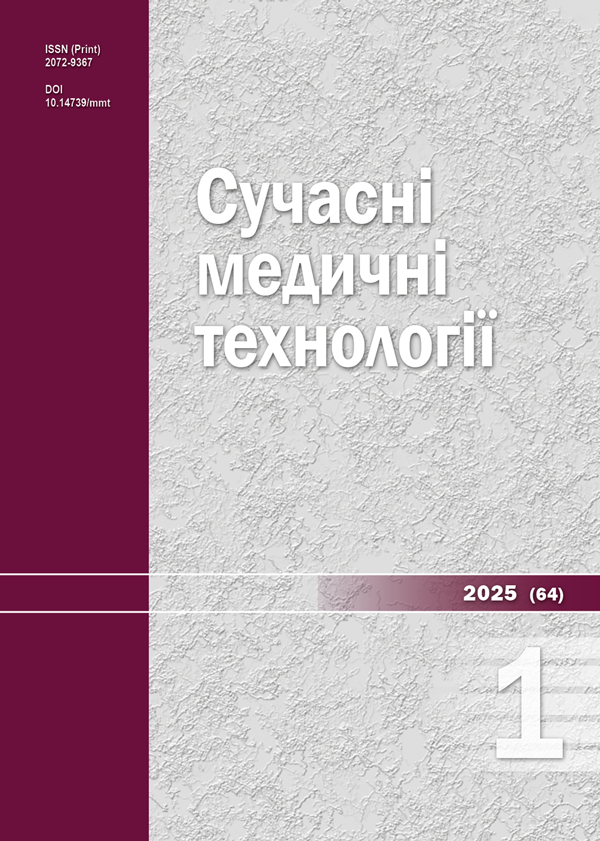First experience of laparoscopic colon resection with primary anastomosis for combat-related thoracoabdominal trauma with through-and-through colon injury
DOI:
https://doi.org/10.14739/mmt.2025.1.320424Keywords:
war-related trauma, thoracoabdominal trauma, laparoscopic anastomosis, linear endoscopic staplerAbstract
Aim: to demonstrate the possibilities and advantages of laparoscopic surgery in combat-related abdominal penetrating trauma with colon injury.
Materials and methods. This case report presents the first experience of laparoscopic colon resection with primary anastomosis for combat-related thoracoabdominal trauma with through-and-through colon injury. A 47-year-old serviceman sustained an explosive penetrating thoracoabdominal injury (dropping explosives from a drone) operated 10 hours after. Initial management at Role 2 included chest tube drainage, surgical debridement, and wound sealing of the chest. CT: penetrating gunshot wound with internal and external damage to the lower lobe of the left lung, perforation of the diaphragm on the left, and transverse colon perforation with a retained metal fragment, pneumoperitoneum, drained hemopneumothorax, and a gunshot fracture of the posterior third of the 5th left rib. Exploratory laparoscopy revealed no free fluid in the abdominal cavity. Surgery: the diaphragmatic perforation was sutured with a 3-0 V-loc barbed suture, the segment of the transverse colon was resected using two Endo-GIA 60 linear staplers according to the severity of injury (AAST Grade 3) and non-viable edges of colon wound. To ensure mobility, a side-to-side antiperistaltic anastomosis was performed using an Endo-GIA 60 stapler (blue cartridge). The anastomosis site was reinforced with a single-layer 3-0 V-loc suture. The procedure was completed with abdominal drainage and port site closure.
Results. Postoperative recovery was without complications. The abdominal drain was removed on the 2nd day, and the pleural drain on the 5th day after the control CT scan. Follow-up after 1.5 month – returned to military service. Our case demonstrates that laparoscopic surgery can be a useful option for combat-related colon injuries when tissue damage is minimal and the patient’s condition is stable. The absence of massive hemoperitoneum and contamination confirms the feasibility of primary repair or anastomosis.
Conclusions. Laparoscopic surgery for combat-related penetrating abdominal trauma with colon injuries is feasible and safe in stable patients. If there are no multiple colon injuries or significant contamination, primary repair or stapled anastomosis is a suitable option.
References
Demetriades D. Colon injuries: new perspectives. Injury. 2004;35(3):217-22. doi: https://doi.org/10.1016/j.injury.2003.11.004
Zeineddin A, Tominaga GT, Crandall M, Almeida M, Schuster KM, Jawad G, et al. Contemporary management and outcomes of penetrating colon injuries: Validation of the 2020 AAST Colon Organ Injury Scale. J Trauma Acute Care Surg. 2023;95(2):213-9. doi: https://doi.org/10.1097/TA.0000000000003969
Tantardini C, Godiris-Petit G, Noullet S, Raux M, Menegaux F, Chereau N. Management of the injured bowel: preserving bowel continuity as a gold standard. BMC Surg. 2021;21(1):339. doi: https://doi.org/10.1186/s12893-021-01332-x
Tang MH, Wong JS, Chia CL, Lee DJ. Meta-analysis on surgical management of colonic injuries in trauma: to divert or to anastomose? Eur J Trauma Emerg Surg. 2021;47(5):1381-8. doi: https://doi.org/10.1007/s00068-020-01555-2
Zhong W, Qiu C, Liu C, Fang C, Xia L, Liang J, et al. Efficacy of Laparoscopic Primary Repair in the Treatment of Colonic Perforation After Colonoscopy: A Review of 40,127 Patients. Surg Laparosc Endosc Percutan Tech. 2016;26(6):e105-8. doi: https://doi.org/10.1097/SLE.0000000000000360
Loberman B, Kuhnreich E, Matter I, Sroka G. Laparoscopic management of iatrogenic colon perforation. Int J Colorectal Dis. 2023;38(1):259. doi: https://doi.org/10.1007/s00384-023-04550-2
Pau L, Navez J, Cawich SO, Dapri G. Laparoscopic Management of Blunt and Penetrating Abdominal Trauma: A Single-Center Experience and Review of the Literature. J Laparoendosc Adv Surg Tech A. 2021;31(11):1262-8. doi: https://doi.org/10.1089/lap.2020.0552
Beltzer C, Bachmann R, Strohäker J, Axt S, Schmidt R, Küper M, et al. Wertigkeit der Laparoskopie beim penetrierenden und stumpfen Abdominaltrauma – ein systematisches Review [Value of laparoscopy in blunt and penetrating abdominal trauma-a systematic review]. Chirurg. 2020;91(7):567-75. German. doi: https://doi.org/10.1007/s00104-020-01158-y
Gumeniuk K, Larionov A, Vikarchuk M, Makarov V, Nehoduiko V, Dotsenko V. [Laparoscopic removal of renal foreign body in an isolated gunshot penetrating abdominal wound (description of two clinical cases)]. Emergency Medicine (Ukraine). 2024;20(5):388-93. Ukrainian. doi: https://doi.org/10.22141/2224-0586.20.5.2024.1738
Gumeniuk K, Lurin I, Savytskyi O, Nehoduiko V, Makarov V, Smolianyk K. Surgical tactics in fire kidney injury and the first experience in performing laparoscopic nephrectomy at the II level of medical support (role II) in combat conditions: Case report. Int J Surg Case Rep. 2023;106:108046. doi: https://doi.org/10.1016/j.ijscr.2023.108046
Lurin I, Vorovskiy O, Makarov V, Khoroshun E, Nehoduiko V, Ryzhenko A, et al. Management of thoracoabdominal gunshot injuries by using minimally invasive surgery at role 2 deployed field hospitals in Ukraine. BMC Surg. 2024;24(1):183. doi: https://doi.org/10.1186/s12893-024-02475-3
Schild-Suhren S, Yilmaz E, Biggemann L, Seif A, Torsello GF, Uhlig A, et al. Management von Verletzungen parenchymatöser Abdominalorgane [Management of Injuries to the Parenchymal Abdominal Organs]. Zentralbl Chir. 2024;149(4):359-67. German. doi: https://doi.org/10.1055/a-2301-7951
Ietto G, Amico F, Pettinato G, Iori V, Carcano G. Laparoscopy in Emergency: Why Not? Advantages of Laparoscopy in Major Emergency: A Review. Life (Basel). 2021;11(9):917. doi: https://doi.org/10.3390/life11090917
Sermonesi G, Tian BWCA, Vallicelli C, Abu-Zidan FM, Damaskos D, Kelly MD, et al. Cesena guidelines: WSES consensus statement on laparoscopic-first approach to general surgery emergencies and abdominal trauma. World J Emerg Surg. 2023;18(1):57. doi: https://doi.org/10.1186/s13017-023-00520-9
Di Saverio S, Birindelli A, Podda M, Segalini E, Piccinini A, Coniglio C, et al. Trauma laparoscopy and the six w's: Why, where, who, when, what, and how? J Trauma Acute Care Surg. 2019;86(2):344-67. doi: https://doi.org/10.1097/TA.0000000000002130
Ndong A, Diallo AC, Diao ML, Tendeng JN, Sarr N, Racine IB, et al. Laparoscopic treatment for colonic injuries following penetrating trauma: A feasible option in a surgical department of Sub-Saharan Africa. Trauma Case Rep. 2022;42:100708. doi: https://doi.org/10.1016/j.tcr.2022.100708
Oosthuizen G, Buitendag J, Variawa S, Čačala S, Kong V, Xu W, et al. Penetrating colonic trauma and damage control surgery: Anastomosis or stoma?. ANZ J Surg. 2021;91(9):1874-80. doi: https://doi.org/10.1111/ans.16939
Downloads
Additional Files
Published
How to Cite
Issue
Section
License
Copyright (c) 2025 Mikheiev Iu. O., Gumeniuk K. V., Tielushko Ya. V., Mialkovskyi D. S., Savchenko S. I.

This work is licensed under a Creative Commons Attribution-NonCommercial 4.0 International License.
The work is provided under the terms of the Public Offer and of Creative Commons Attribution-NonCommercial 4.0 International (CC BY-NC 4.0). This license allows an unlimited number of persons to reproduce and share the Licensed Material in all media and formats. Any use of the Licensed Material shall contain an identification of its Creator(s) and must be for non-commercial purposes only.














